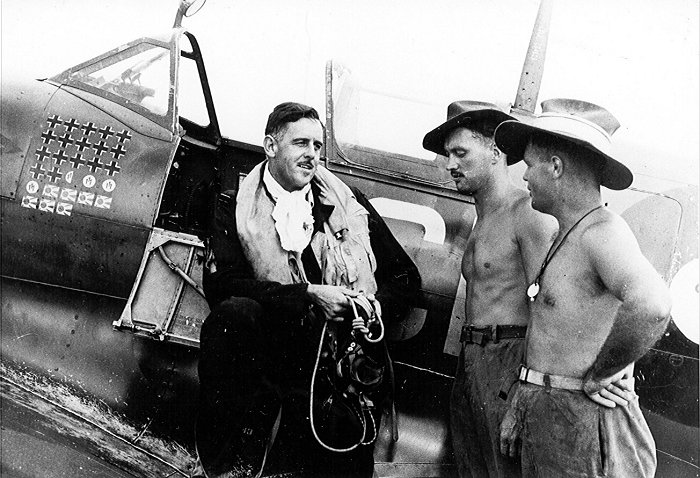
|
KIT: |
Hasegawa 1/48 Spitfire VIII |
|
KIT # |
9079 (JT 79) |
|
PRICE: |
$26.98 |
|
DECALS: |
see review |
|
REVIEW & |
|
|
NOTES: |
` |
BUILDING CLIVE CALDWELL'S SPITFIRE VIII

|
HISTORY |

The Royal Australian Air Force was always on the far end of a very long supply line - either from Great Britain or the United States - throughout the Second World War, which meant there was a constant struggle to obtain first-class combat aircraft.
When the Japanese began their attacks against Darwin in 1942, the RAAF were able to convince the British that they needed the return of three RAAF Squadrons from the Middle East, and the provision of at least two more RAF squadrons - mounted on first-class aircraft - to provide effective air defense. The result was the entry of the Supermarine Spitfire Vc into combat in the Southwest Pacific Theater.
Given the range limitations of the Spitfire, it was not really suited to the needs of the theater, and General George Kenney, USAAF, who commanded the Allied air forces in the SWPA, did not favor its presence. However, he also refused RAAF requests to equip with the P-51 Mustang. The RAAF was left with no alternative but to update the Spitfire force, and this began when the RAAF received 251 F.VIIIs, serials A58-300 to 550, from November 1943 through July 1944.
Markings and Camouflage:
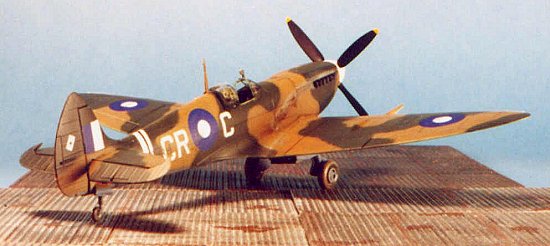 Modelers have long been interested in these Australian Spitfires, and have
had to put up with a lot of misleading information regarding the camouflage and
markings. Fortunately there is now a body of recent research available, which
goes far toward solving the problem. I am indebted to RAAF historical researcher
Peter Malone for providing the following information.
Modelers have long been interested in these Australian Spitfires, and have
had to put up with a lot of misleading information regarding the camouflage and
markings. Fortunately there is now a body of recent research available, which
goes far toward solving the problem. I am indebted to RAAF historical researcher
Peter Malone for providing the following information.
The Spitfire VIIIs arrived in Australia in desert camouflage. Repainting was done initially at the Aircraft Depots, but later aircraft seem to have been issued to the squadrons still in RAF desert camouflage and were repainted at unit level.
There appear to have been two basic schemes. Where there was time, the entire aircraft was repainted, with the upper surfaces in RAAF Foliage Green and the undersurfaces in RAAF Sky Blue. For these aircraft, the demarcation line between the upper and lower colors on the nose followed the panel line between the lower and side engine cowlings. The RAAF paints had a slight sheen and appear to be glossy in some photos.
 On other aircraft, the RAF Dark Earth and Azure Blue were retained but the
RAF Middle Stone was over-painted with RAAF Foliage Green. Close examination of
photos often reveals over-spray from the Foliage Green on the Azure Blue. On
these aircraft the upper/lower color demarcation line followed that of the
original pattern. There seem to have been three basic styles, which closely
follow the patterns which can be seen on desert finished Spitfire VIIIs in the
Middle East and Italy, and which may be related to which factory built the
particular airplane. Looking at the nose, these patterns were: 1) A fairly
straight line, about two thirds up the lower cowling; 2) Azure Blue in a narrow
band under the cowling ahead of the intake, with <loops=
of upper surface camouflage down the sides of the intake/filter; 3)Azure Blue in
an oval shape under the front-lower cowling and a narrow band under the
intake/filter.
On other aircraft, the RAF Dark Earth and Azure Blue were retained but the
RAF Middle Stone was over-painted with RAAF Foliage Green. Close examination of
photos often reveals over-spray from the Foliage Green on the Azure Blue. On
these aircraft the upper/lower color demarcation line followed that of the
original pattern. There seem to have been three basic styles, which closely
follow the patterns which can be seen on desert finished Spitfire VIIIs in the
Middle East and Italy, and which may be related to which factory built the
particular airplane. Looking at the nose, these patterns were: 1) A fairly
straight line, about two thirds up the lower cowling; 2) Azure Blue in a narrow
band under the cowling ahead of the intake, with <loops=
of upper surface camouflage down the sides of the intake/filter; 3)Azure Blue in
an oval shape under the front-lower cowling and a narrow band under the
intake/filter.
The last group of Spitfire VIIIs received were the H.F. VIII version, and were all finished in the standard day fighter scheme of Ocean Grey/Dark Green upper surfaces and Sea Grey Medium lower surfaces. The RAAF received 159 of the H.F.VIII variant, serialled A58-600 to 758, from September 1944. They retained the standard scheme in Australian service.
The result of this is: a photograph of a Spitfire in the 300-550 range that looks overall one dark color is most likely the Foliage Green/Sky Blue scheme, while one in the same serial range with dark colors in a disruptive two-color upper scheme is most likely the Dark Earth/Foliage Green/Azure Blue scheme. Any Spitfire VII with a serial above 600 is Ocean Grey/Dark Green/Sea Grey Medium.
Caldwell's Spitfire:
Clive "Killer" Caldwell was the leading Australian fighter ace in the Western Desert. As such, when the Australian squadrons were recalled for the defense of the homeland, he returned and took command of the Darwin wing. Flying the Spitfire Vc, he scored seven victories over the Japanese. When 80 Wing re-equipped with the Spitfire VIII in 1944, Caldwell moved up to Wing Commander, while fellow ace Robert Gibbes became the Wing Leader. The position of Wing Commander is primarily administrative, and did not involve regularly flying on operations, though Caldwell did his best to keep his hand in.
His first Spitfire is the more famous of the two, and almost all information that has been recorded about it previously is incorrect.
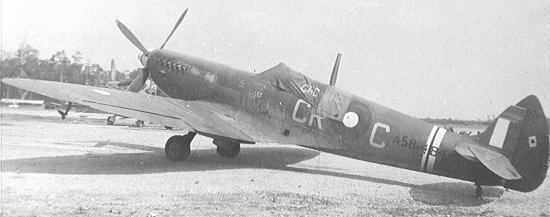 For starters, Caldwell never flew A58-464. This error dates back many years,
when a researcher noted this serial number in Caldwell=s logbook. An article appeared in one of
the first IPMS-USA Quarterly magazines that embellished the facts a little
(surprise surprise) and the error has been repeated at regular intervals ever
since. Squadron, maintenance, and -464=s
status card all confirm it got nowhere near Darwin: in fact an operational unit
never flew it. -464 was a transcription error for -484. If you look at the side
view photograph of Caldwell's Spitfire VIII published here courtesy of Peter
Malone, the "8" of "-484" is clearly visible against the
white rear fuselage band.
For starters, Caldwell never flew A58-464. This error dates back many years,
when a researcher noted this serial number in Caldwell=s logbook. An article appeared in one of
the first IPMS-USA Quarterly magazines that embellished the facts a little
(surprise surprise) and the error has been repeated at regular intervals ever
since. Squadron, maintenance, and -464=s
status card all confirm it got nowhere near Darwin: in fact an operational unit
never flew it. -464 was a transcription error for -484. If you look at the side
view photograph of Caldwell's Spitfire VIII published here courtesy of Peter
Malone, the "8" of "-484" is clearly visible against the
white rear fuselage band.
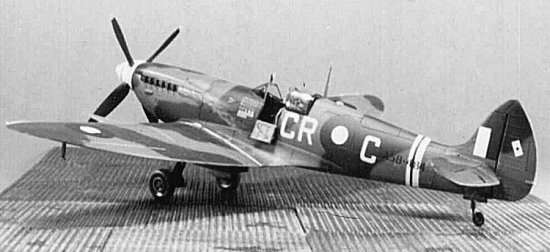 A58-484, the Spitfire VIII Caldwell actually flew, was maintained by 457 Sqn
from July 1944 and then 452 from Nov 1944.
A58-484, the Spitfire VIII Caldwell actually flew, was maintained by 457 Sqn
from July 1944 and then 452 from Nov 1944.
Caldwell=s A58-484 was one of those that had the Middle Stone over-painted with RAAF Foliage Green. The proof is seen in close examination of several photographs where the stencil JG543 (the RAF serial of this aircraft) can be seen on such items as the antenna mast; this was done to insure when the aircraft were re-erected after being knocked down for shipping that the original parts were reattached - these may have been mass-produced, but there were small detail differences between airplanes, which made this necessary. When the RAAF repainted airplanes - after reassembling them - there was no need to keep these stencils. Where these can be found, this proves that these are parts of the aircraft that were painted in RAF Dark Earth.
The colors for A58-484 therefore would have been RAF Dark Earth and RAAF Foliage Green over RAF Azure Blue. The letter codes would be Sky Blue - not white as has been frequently stated; the serial is black, with the rear fuselage band white with black stripe. The spinner bands were red, not black, as has been previously stated. One can look at the side view photo of Caldwell's Spitfire and see the tonal differences between the letter codes (sky blue) and the center of the national insignia (white), quite clearly.
|
CONSTRUCTION |
For a detailed description of building the Hasegawa kit, I refer you to my previous review of the Mk.IXc version. Building a Mk. VIII from the kit is easily accomplished, since all the parts needed are already provided. Substitute the rear fuselage section with the retractable tail wheel, with its associated gear doors and tail wheel , and use the pointed rudder. The only other change from building a Mk.IX kit is to fill in the aileron hinge line outboard of the engraved panel line that marks the outer edge of the short-span aileron. Voila! the Mk.IXc is transformed into a Mk.VIII. I also used a 108-gallon slipper tank from the old Otaki Spitfire kit, since photos show that Caldwell's Spitfire was equipped with this item.
|
PAINT & DECALS |
Painting:
 I first pre-shaded the model, then painted the lower surfaces Azure Blue - in
this case, this was a mixture of Gunze-Sanyo "Intermediate Blue" and
"Light Gull Grey" to match the color shown in a color photo I have of
"Fargo Express," which was painted in the standard RAF desert
camouflage. I masked off the lower surfaces, so that there was only the narrow
band of Azure Blue ahead of the intake/filter, and on the lower surface of the
intake/filter, as shown in photographs. The Dark Earth areas were free-handed,
using Gunze-Sanyo Dark Earth; I made sure that the demarcation between Dark
Earth and Azure Blue was a "hard edge" by masking. When this was dry,
I removed the masking, and then freehanded the Foliage Green. RAAF Foliage Green
is a color very close to RLM70 Black-Green, so I used Gunze-Sanyo RLM70. This
way I had the oversprayed look that would have been correct for this airplane.
To do freehand camouflage, I make sure I have thinned the paint 50-50 with
rubbing alcohol, then tighten down the #1 Fine Tip of my Paasche Model H to get
a nice thin line for drawing demarcations.
I first pre-shaded the model, then painted the lower surfaces Azure Blue - in
this case, this was a mixture of Gunze-Sanyo "Intermediate Blue" and
"Light Gull Grey" to match the color shown in a color photo I have of
"Fargo Express," which was painted in the standard RAF desert
camouflage. I masked off the lower surfaces, so that there was only the narrow
band of Azure Blue ahead of the intake/filter, and on the lower surface of the
intake/filter, as shown in photographs. The Dark Earth areas were free-handed,
using Gunze-Sanyo Dark Earth; I made sure that the demarcation between Dark
Earth and Azure Blue was a "hard edge" by masking. When this was dry,
I removed the masking, and then freehanded the Foliage Green. RAAF Foliage Green
is a color very close to RLM70 Black-Green, so I used Gunze-Sanyo RLM70. This
way I had the oversprayed look that would have been correct for this airplane.
To do freehand camouflage, I make sure I have thinned the paint 50-50 with
rubbing alcohol, then tighten down the #1 Fine Tip of my Paasche Model H to get
a nice thin line for drawing demarcations.
When all this was dry, I masked off the area for the rear fuselage stripe and the leading edges of the wings, and painted these white; I made sure this was not totally even in application, so that it would look like it was painted over the camouflage, which in fact was how it was done on the original. I painted the spinner red, then masked off the two stripes, and then overpainted the spinner white. The slipper tank was painted RAAF Sky Blue; this color closely approximates RLM65 Hellblau, and I used Gunze-Sanyo RLM65 to do this.
Decals:
I had both the Aeromaster and SuperScale sheets for Caldwell's airplane. Most of these markings are incorrect, but I was able to piece together the serial A58-484 by using an "8" from the serial for another airplane on the sheet. The scoreboard on the SuperScale sheet is closer to correct in size from a study of the photographs than is the Aeromaster item, so I used that. I also used the "Ace of Spades" insignia for 80 Wing from the SuperScale sheet.
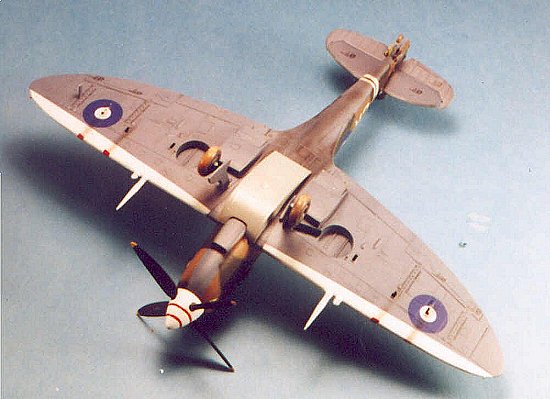 The national insignia was all replaced with RAAF national insignia from a Red
Roo Mustang sheet. The fin flash provided in both the SuperScale and Aeromaster
sheets is too big, since it is basically the RAF fin flash minus the red area.
The roundels are also either too big (upper wing) or too small (fuselage and
lower wing) on the Aeromaster and SuperScale sheets, while it is just right on
the Red Roo sheet.
The national insignia was all replaced with RAAF national insignia from a Red
Roo Mustang sheet. The fin flash provided in both the SuperScale and Aeromaster
sheets is too big, since it is basically the RAF fin flash minus the red area.
The roundels are also either too big (upper wing) or too small (fuselage and
lower wing) on the Aeromaster and SuperScale sheets, while it is just right on
the Red Roo sheet.
For the letter codes, I used letters from a SuperScale 1/72 RAF codes and letters sheet (72-46). The new release of this sheet is not the right color for RAF "Sky", being too blue, but is a perfect rendition of RAAF Sky Blue. These are also smaller than the letter codes on the Aeromaster and SuperScale sheets, which are too big when compared with photographs.
I used the kit decals for all the stenciling, being sure not to put any of the stencils on the Foliage Green areas, other than the upper surface wing-walk lines, which would have been repainted.
For those of you who are thinking "this is all very complicated," I agree. I am in hopes that Red Roo will take the opportunity when they release Peter Malone's upcoming book on RAAF Spitfire Camouflage and Markings (which I already recommend, based on the information I have been provided by Mr. Malone) to release accurate decals for this airplane and Robert Gibbes' airplane (and any others they want to do). Red Roo decals are excellent in application, and thoroughly researched.
Final Assembly and Finish:
After giving the model its final coats of Dullcote, I weathered it by scuffing the left wing root, per the photographs. The airplane was kept in excellent condition, so there was no other dings of the paint. I created the exhaust stain by using a very thin mixture of Gunze Sanyo "Light Gull Grey" to get the staining that came from running the engine on a very lean mixture, with an overspray of Tamiya "Smoke". I also used the "smoke" on the lower central area of the wing and lower fuselage, for the oil stains.
The landing gear, pitot tube, canopy, radio mast, slipper tank, and propeller were finally attached, and the model was finished.
|
CONCLUSIONS |
 After many attempts over the years, I think I finally have an accurate
model of Clive Caldwell's Spitfire VIII for my collection. Turning the Hasegawa
kit into a Spitfire VIII is extremely easy, and this provides the modeler with a
number of different schemes - the RAF Desert scheme for "Fargo
Express" if you want to do an American Spitfire, various SEAC and
Australian airplanes, etc. I'll be doing more RAF European Spitfires when
Hasegawa releases the Mk.IXB version towards the end of the year. I know I will
do more Australian Spitfires if Red Roo comes through for us. (hint, hint!)
After many attempts over the years, I think I finally have an accurate
model of Clive Caldwell's Spitfire VIII for my collection. Turning the Hasegawa
kit into a Spitfire VIII is extremely easy, and this provides the modeler with a
number of different schemes - the RAF Desert scheme for "Fargo
Express" if you want to do an American Spitfire, various SEAC and
Australian airplanes, etc. I'll be doing more RAF European Spitfires when
Hasegawa releases the Mk.IXB version towards the end of the year. I know I will
do more Australian Spitfires if Red Roo comes through for us. (hint, hint!)
Thanks to HobbyLink Japan for providing the review copy. Your support is appreciated.
If you would like your product reviewed fairly and quickly by a site that averages over 3,000 visits a day, please contact me or see other details in the Note to Contributors.